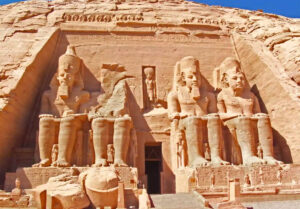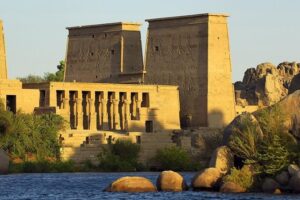Ramesses II: The Pharaoh of Immortality
Ramesses II, often referred to as Ramesses the Great, stands as one of the most celebrated and powerful pharaohs in ancient Egyptian history. Ruling for an extraordinary 66 years (c. 1279-1213 BCE) during the 19th Dynasty, his reign marked a period of immense prosperity, monumental construction, and military strength for the New Kingdom. His legacy is etched in stone across the landscape of Egypt, from his iconic statues to the countless temples he commissioned.
Ramesses II was a pharaoh of grand ambition. His most famous military campaign was against the Hittite Empire, culminating in the Battle of Kadesh (c. 1274 BCE). Though Ramesses’s own accounts portray a heroic, one-man victory, modern historians often view it as a strategic stalemate. What is undeniable, however, is the subsequent peace treaty with the Hittites, the first known in world history, which brought stability to the region and established a new balance of power.
Contributions:
Beyond his military prowess, Ramesses was a prolific builder. His grand capital city, Pi-Ramesses, was a marvel of architecture and engineering, but his most enduring monuments are the colossal temples and statues he erected. The Abu Simbel temples, with their four massive seated statues of the pharaoh, are a breathtaking testament to his self-proclaimed divinity and power. He also completed the magnificent Hypostyle Hall at the Temple of Karnak and added to the Luxor Temple, leaving his mark on the most sacred sites in Egypt.
Ramesses II lived to be over 90 years old, an incredible age for the ancient world. His long life and reign allowed him to outlive many of his children and secure the succession of his son, Merneptah. His mummy, now housed in the Egyptian Museum in Cairo, provides a remarkable glimpse into the physical appearance of the legendary pharaoh, showing signs of severe arthritis and dental issues that plagued him in old age.
Ramesses II’s reign was a golden age for Egypt. He was not just a king but a symbol of Egyptian might, a warrior, builder, and statesman who shaped the very landscape of his empire and left an immortal legacy that continues to captivate the world.
Controversial Theories about Ramesses II (Ramesses the Great)
Ramesses II, the third pharaoh of the Nineteenth Dynasty, ruled Egypt for an astonishing 66 years (c. 1279–1213 BCE). Scholars often consider him one of the most powerful and celebrated rulers of the New Kingdom because he was known for his monumental building projects, military prowess, and long life. However, despite his widely acknowledged greatness, his legacy is not without its share of controversial theories and historical debates. This research explores some of the most significant and debated aspects of his reign, challenging the conventional narrative.
1. The Battle of Kadesh: Victory or Stalemate?
The Battle of Kadesh was fought between the Egyptian Empire and the Hittite Empire. Ramesses II led the Egyptians, while Muwatalli II led the Hittites. Consequently, it is arguably one of the most famous battles of the ancient world. Furthermore, Ramesses II’s official account is inscribed on many temples throughout Egypt. In this account, it portrays the battle as a glorious and decisive Egyptian victory. Specifically, these inscriptions depict the pharaoh as a lone hero. In fact, he fought valiantly against overwhelming odds and single-handedly turned the tide of the battle with divine intervention.
However, many modern historians and Egyptologists dispute Ramesses’s self-proclaimed victory. Instead, they argue that the battle was, at best, a strategic stalemate or even a tactical defeat for the Egyptians. Ultimately, the main points of contention are:
- Deceptive Propaganda: Ramesses’s account is a masterclass in ancient propaganda. He was ambushed by the Hittites and his army was scattered. The arrival of Egyptian reinforcements saved him from complete annihilation. While he did manage to rally his troops and push the Hittites back, he failed to capture Kadesh, the city he had marched to conquer.
- Hittite Inscriptions: Hittite records from their capital Hattusa offer a different perspective, suggesting they successfully defended their territory and maintained control over Kadesh.
- The Peace Treaty: The subsequent peace treaty, signed 16 years after the battle, further undermines Ramesses’s claim of a decisive victory. This treaty, the first known in world history, established a pact of mutual non-aggression and assistance, suggesting a balance of power rather than a clear Egyptian dominance. The fact that Ramesses did not gain any significant territory from the war supports the idea of a stalemate.
2. Ramesses II and the Biblical Exodus
For centuries, Ramesses II has been a central figure in popular culture. He is also central to religious interpretations. Many see him as the pharaoh of the Exodus. The biblical text mentions the Israelites building “store cities, Pithom and Rameses” (Exodus 1:11). This has led many to link Ramesses II to the oppression of the Israelites. They also link him to the Israelites’ subsequent flight from Egypt.
Controversial Theory:
A significant number of scholars and archaeologists reject the connection between Ramesses II and the Exodus. The theory is largely considered a popular misconception stemming from a lack of historical and archaeological evidence.
- Absence of Evidence: There is no Egyptian historical record, text, or archaeological evidence that corroborates a mass exodus of a large Semitic population from Egypt during Ramesses II’s reign.
- Avaris vs. Pi-Ramesses: While the Bible mentions the city of “Rameses,” archaeological discoveries have revealed that the city of Pi-Ramesses, Ramesses II’s new capital, was built on top of an older Hyksos-era city named Avaris. Some scholars argue that the biblical text might be referring to the location rather than the specific pharaoh, or that the name was an anachronistic update to the text in a later period.
- Anachronism: The historical and archaeological context of Canaan during Ramesses II’s reign does not align with the biblical narrative of the Israelite conquest. Many of the cities mentioned in the conquest narrative were either already in ruins or were under firm Egyptian control, making a large-scale invasion unlikely.
Alternative theories for the Exodus place it in different periods. One theory suggests the expulsion of the Hyksos. The Hyksos were a Semitic group that ruled parts of Egypt. Another theory suggests the reign of other pharaohs. However, no definitive archaeological evidence has been found. This evidence would support any of the proposed timelines.
3. The “Harem Conspiracy” and Ramesses II’s Death
The most famous “Harem Conspiracy” targeted Ramesses III. However, some historical sources and modern analysis have led to a less-known theory. This theory is still debated. It surrounds Ramesses II’s death.
Controversial Theory: While Ramesses II lived to a remarkable age for his time, some theories have emerged regarding a potential assassination attempt.
- Possible Conspiracy: Some sources suggest that the polygamous nature of the royal household could have led to rivalries among his numerous wives and their sons, potentially leading to plots for succession. While no definitive evidence of a successful assassination plot has been found for Ramesses II, the documented conspiracy against Ramesses III shows that such plots were a real threat.
- Physical Evidence: A 2012 study on the mummy of Ramesses III revealed a severe throat gash, confirming his assassination. This has prompted some to look for similar evidence in other royal mummies, leading to speculation.
The primary historical and medical evidence points to Ramesses II’s natural death. He died at an old age. His mummy shows signs of severe arthritis and dental problems. These are common ailments for a nonagenarian. There is no clear evidence of a violent death.
4. Ramesses II’s Appearance and Ancestry
Ramesses II’s physical appearance, particularly his hair color, has been a subject of ongoing debate. His mummy reveals reddish-blond hair, which has led to speculation about his origins.
Controversial Theory: Some have used his hair color as a basis for claiming European ancestry.
- Genetic Admixture: Genetic studies show that ancient Egyptians had genetic ties to populations in the Levant and parts of North Africa, a connection we would expect given the interconnectedness of the Mediterranean world.
- Red Hair in the Region: We find red hair and lighter skin in North Africa and the Middle East; the presence of these traits is not exclusive to Europe. For example, the Y-haplogroup E-V22, which we associate with his paternal lineage, appears predominantly in Northeast Africa.
- The “Ginger” Phenotype: While researchers describe Ramesses II’s hair as red, the mummification process likely changed the pigment over time. The henna used in the embalming process could have caused the red-brown color.
The idea of a “European” pharaoh is largely a product of modern pop culture and misinterpretations of scientific data. The overwhelming evidence supports his indigenous Egyptian and North African/Levantine ancestry.
Ramesses II remains a fascinating and complex figure. The traditional view of him is a flawless warrior-king. This view is a product of his own effective propaganda. But historical research and archaeological discoveries have allowed for a more nuanced understanding of his reign. They have also led to a more critical understanding. The controversial theories surrounding him highlight the ongoing process of historical inquiry. They also show the importance of critically evaluating ancient and modern sources. These debates do not diminish his significance. Rather, they add to the richness of his legacy. They show that even the greatest pharaohs are subject to the reinterpretation of history.
Before you go tour Egypt, check Egypt’s weather.











